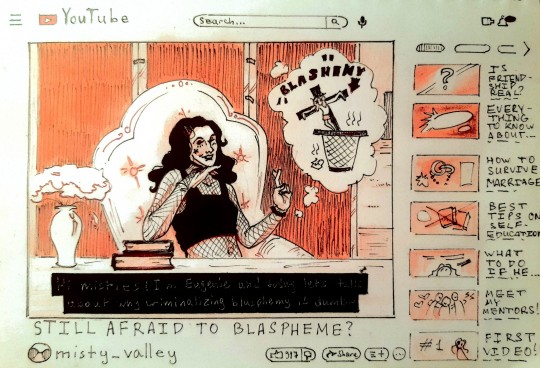#kidtube
Explore tagged Tumblr posts
Text


Repostober day 4: Boudoir Influencer
Based on a very uncomfortable thought that in the modern AU, Eugenie, who was supposed to spread her "mentors" ' ideas among her peers, could become a kidtuber video essayist sponsored by them.
6 notes
·
View notes
Link
some preliminary points about these that get obscured by the pathological American need (both on the part of the author, and of Alice Maz who I picked this up from) to sort things into “Good” or “Bad” (or, more historically, “Safe” or “Unsafe”) before understanding almost anything about them 1. The level of violence in these kids’ Youtube videos is nothing new: it’s a reversion to fairytales in which giants get killed, little girls get eaten by wolves and tailors cut off kids’ thumbs for sucking on them. The recombinatory arbitrariness of the plots is also characteristic of many, many fairy tales that haven’t stood the test of time. (On the contrary, the “crying Agnes” Bridle represents as a BEN Drowned creepypasta-style apparition haunting a narrative it doesn’t belong to is obviously rather a traditionally dark didactic figure, crying when the wrong head is attached and laughing when the right one is.) The opposition of “cyberpunk” and “cybergothic” always supposed, more or less, that technofuturity would trap the elites in crystalline hauntological illusions of the culturally remembered past, while releasing the underclass by decomposition into an anarchic hypostasis of pure primitivity and pure futurity. Can we - must we - instead learn to think the “cyberfolkloric”? 2. More than old fairy tales, though, what these remind me of is Axe Cop. They’re almost indistinguishable from the non-stories children themselves develop in free-form play, especially with toys - down to the random assortment of characters, the abstract or typical settings, and even the stiff, artificial movement of the inert figures. Of course, they are not the same thing - they are observed passively, from behind a level of mediation. This extreme bareness of mediation is that of the uncanny valley or Old Venn’s mirror; the difference it imposes on childhood play might be complete inversion. What would constitute the exact inversion of (bourgeois) childhood play is a much more complicated question than this article poses. 3. The conclusion that these are automated - non-human - from their lack of coherence within culturally contextual codes in many cases may be no more justified than the claim of IQ tests to measure intelligence as a representation of humanity: a Turing test poses the exact same problematics of legibility. The indistinguishability of the algorithmic and the foreign (exacerbated by cyber-Taylorized forms of labour in the global South) is a uniquely Online structure of feeling, extending from the ambiguity of fake news and propaganda bots to the language of shitposting. (In the Sandsverse blogs, which depend on the language of shitposting understood as a “xenopoetics”, a third term, the divine or supernatural, resolves the ambiguous form of Otherness - as it does in Bridle’s insistent representation of the videos as haunting or haunted.) The “Wrong Heads” video, Bridle’s example of algorithmic breaking through human logic, is the most clearly organized and didactic (the least Axe Cop) in the article, to an extent that would be extremely difficult for an algorithm to compose. His evidence of its inhuman origin is the seemingly random word order of the title, which pragmatically uses the title as a tag cloud rather than the “headline” of literary and journalistic convention, and the apparently “disturbing” nature of the content. The content most Western commentators I’ve seen on this phenomenon tend to deem disturbing (notably, in this article, any instance of a child crying) is only so within the unusually sanitized (and literalistic) ideologies and realities of childhood in the First World Anglosphere: where, for example, a dentist is unlikely to have to perform any unusual operations on a child in the first place, but if they do, will unquestionably (or face lawsuits) be "kindly”, “appropriately reassuring” and use heavy anaesthetic. 4. Most of these videos are almost completely non-verbal. (Assuming them to be international spam productions, that’s an obvious advantage.) I can’t find who on Twitter was saying just this weekend that I can’t remember which theorist’s prediction that “the technological image (?)” would replace text as the dominant medium of thought has resoundingly failed. Kids’ Youtube seems to be an exception, and depending on what becomes of kids raised on it, [theorist] might just have been off by a generation. 5. There’s one point in this article where the author seems to imply that ad revenue isn’t enough to explain the proliferation and budget of these videos, but it’s rapidly shoved under the rug, leading to the remarkable closed inquiry “whatever their conscious intention (i.e. to accumulate ad revenue)”. Why does the author panic at this point? Sincere, autonomous cultural production would be one explanation but even I find the videos lack many traces of it. Then are they being produced for some other purpose? Cognitive programming, for example? Subliminal messages? It’s clearly the implication, is my guy just afraid of sounding “crazy” (like “9/11 conspiracy theorists”)? Come on, it’s 2017. Anything can happen.
87 notes
·
View notes